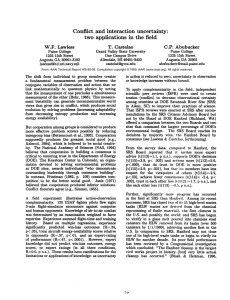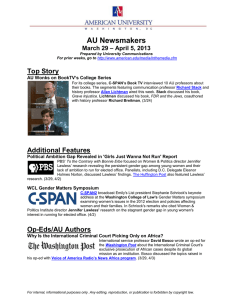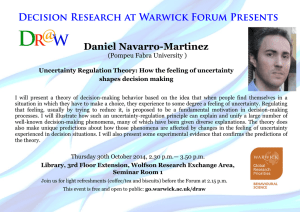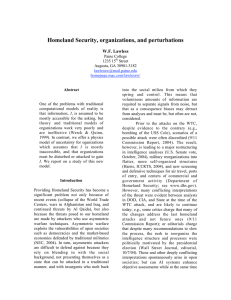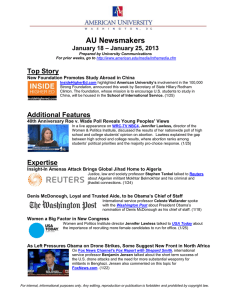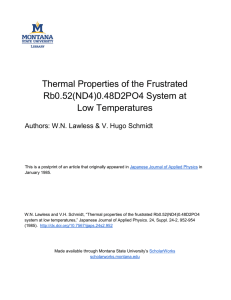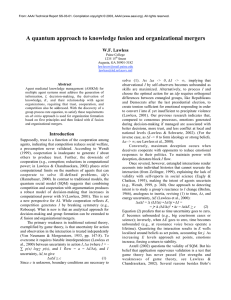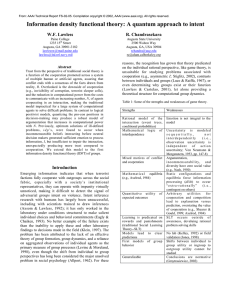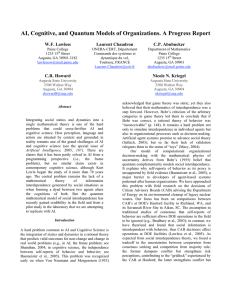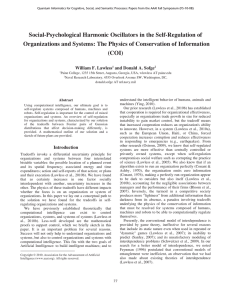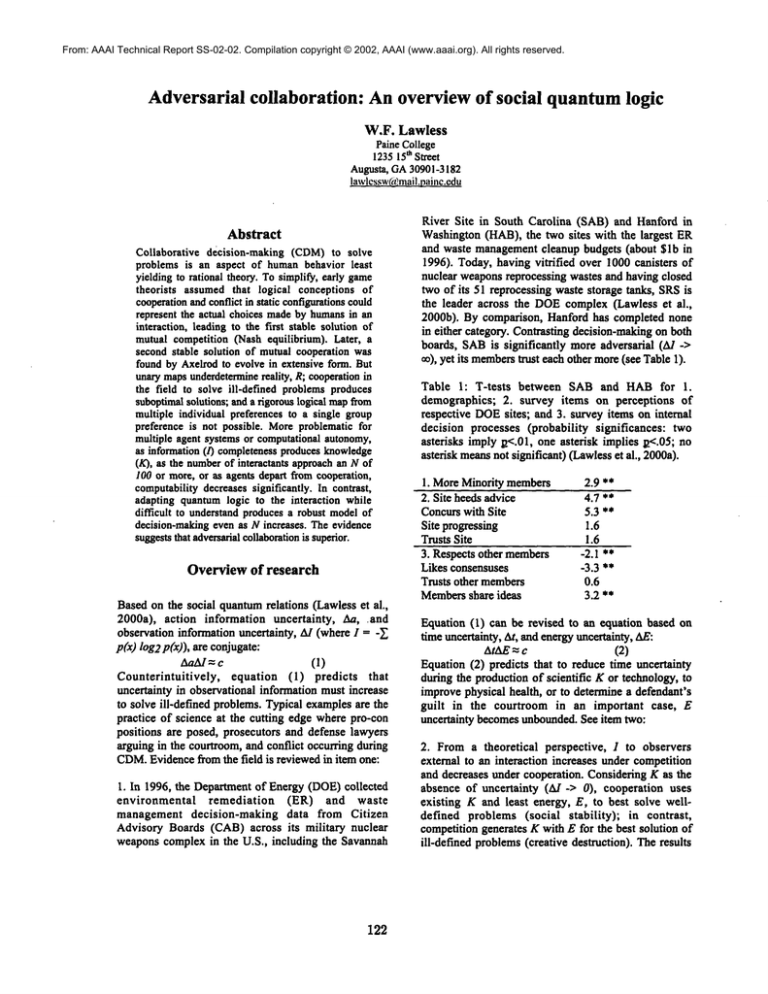
From: AAAI Technical Report SS-02-02. Compilation copyright © 2002, AAAI (www.aaai.org). All rights reserved.
Adversarial collaboration: Anoverview of social quantumlogic
W.F. Lawless
Paine College
123515th Street
Augusta, GA30901-3182
lawlessw(it~mail.painc.cdu
Abstract
Collaborative decision-making (CDM)to solve
problems is an aspect of human behavior least
yielding to rational theory. To simplify, early game
theorists assumed that logical conceptions of
cooperationandconflict in static configurationscould
represent the actual choices madeby humansin an
interaction, leading to the first stable solution of
mutual competition (Nash equilibrium). Later,
second stable solution of mutual cooperation was
found by Axelrod to evolve in extensive form. But
unary mapsunderdeterminereality, R; cooperation in
the field to solve ill-defined problems produces
suboptimalsolutions; and a rigorous logical mapfrom
multiple individual preferences to a single group
preference is not possible. Moreproblematic for
multiple agent systems or computational autonomy,
as information (/) completeness produces knowledge
(K), as the numberof interactants approachan N
100 or more, or as agents depart from cooperation,
computability decreases significantly. In contrast,
adapting quantum logic to the interaction while
difficult to understand produces a robust model of
decision-making even as N increases. The evidence
suggeststhat adversarialcollaborationis superior.
Overview of research
Based on the social quantum relations (Lawless et al.,
2000a), action information uncertainty,
Aa, and
observation information uncertainty, A/(where I = -Y~
p(x) log2 p(x)), conjugate:
AaAl= c
(1)
Counterintuitively,
equation (1) predicts
that
uncertainty in observational information must increase
to solve ill-defined problems. Typical examples are the
practice of science at the cutting edge where pro-con
positions are posed, prosecutors and defense lawyers
arguing in the courtroom, and conflict occurring during
CDM.Evidence from the field is reviewed in item one:
I. In 1996, the Department of Energy (DOE) collected
environmental
remediation
(ER) and waste
management decision-making
data from Citizen
Advisory Boards (CAB) across its military nuclear
weapons complex in the U.S., including the Savannah
122
River Site in South Carolina (SAB) and Hartford
Washington (HAB), the two sites with the largest
and waste management cleanup budgets (about $1b in
1996). Today, having vitrified over 1000 canisters of
nuclear weapons reprocessing wastes and having closed
two of its 51 reprocessing waste storage tanks, SRSis
the leader across the DOEcomplex (Lawless et al.,
2000b). By comparison, Hanford has completed none
in either category. Contrasting decision-making on both
boards, SABis significantly
more adversarial (A/->
~), yet its memberstrust each other more (see Table 1).
Table 1: T-tests
between SAB and HAB for 1.
demographics; 2. survey items on perceptions
of
respective DOEsites; and 3. survey items on internal
decision processes (probability
siguiflcances:
two
asterisks imply 2<.01, one asterisk implies 1~<.05; no
asterisk meansnot significant) (Lawless et al., 2000a).
1. More Minority members
2. Site heeds advice
Concurs with Site
Site progressing
Trusts Site
3. Respects other members
Likes consensuses
Trusts other members
Membersshare ideas
2.9
4.7
5.3
1.6
1.6
-2.1
-3.3
0.6
3.2
**
**
**
**
**
**
Equation (1) can be revised to an equation based
time uncertainty, At, and energy uncertainty, AE:
AtAE= c
(2)
Equation (2) predicts that to reduce time uncertainty
during the production of scientific K or technology, to
improve physical health, or to determine a defendant’s
guilt in the courtroom in an important case, E
uncertainty becomes unbounded. See item two:
2. From a theoretical
perspective,
] to observers
external to an interaction increases under competition
and decreases under cooperation. Considering K as the
absence of uncertainty (A/-> 0), cooperation uses
existing K and least energy, E, to best solve welldefined problems (social stability);
in contrast,
competition generates K with E for the best solution of
ill-defined problems (creative destruction). The results
froma study of 15 nations (the nations wereselected by
May, 1997, for his study of graduate education)
indicate that the moreeconomicfreedomallowed and E
expended,the morescientific wealth, technology and
the better physical health that accrued (Table 2).
contrast, unrestrained cooperation is associated with
social loafing, asymmetricI (e.g., spying, terrorism,
command
economies, monopolies), and corruption.
Table2. Correlation matrix (truncated) for 15 nations
betweenScientific Wealth(SW), Health (/-/), Energy
expenditure, E, personal computers per 1,000 capita
(pc’s), internet web hosts per 10,000 capita (web),
EconomicFreedom(EF), and Corruption Perceptions
(CPI)(probabilitysignificances:< . 01for r > .65;12 <
.05 for r > .5) (fromLawless&Castelao, 2001).
RC!
H
E
pc’s
web
EF
CPI
1.0
-.72
.73
.93
.61
.88
.81
1.0
-.66
-.70
-.37
-.79
-.72
1.0
.78
.74
.70
.73
1.0
.71
.84
.89
1.0
.48
.60
In complex environments, CDMshould make users
more familiar with the uncertainties associated with
automationtools (Helmreich,2000). See item three:
3. The next study consideredthe effect of collaborative
decision-making (CDM)versus adversarial decisionmaking. The Federal Aviation
Agency has
implemented CDMto improve convective weather
forecasts (e.g., thunderstorms, tornados, hail) for
commercialaviation (Table 3). Experts produced the
best convectiveforecasts over the near term, followed
by CDMthen numerical models. CDMwas less
efficacious probably to increase safety margins and
passenger comfort, but probably also because virtually
no conflict occurred during CDM.CDMimproved the
facility of using automated
forecasts.
Table 3. Better convective weather forecasts cover less
area, have greater PODy(probability of being observed),
lower FAR(false-alarm ratio), and Bias near one (the
tendencyto over or underpredict) (see Lawless,2002).
Forecast
Product
Human/
Automated
Area
covered
CDM
Expert-lh
Expert-6h
NCWF
H
H
H
A
5.2%
2.3%
14.9%
0.5%
Ave. FAR Bias
PODy
.28
.28
.04
.09
.84
.70
.92
.41
1.9
1.0
6.1
0.1
123
4. Future research. The difficulty with humanresearch is
that surveys give only static information. Social
influence occurs outside of the individual rational
perspective tapped by surveys (Lawless, 2001). In
attempt to build on a rational, social quantummodelof
emotion, we comparedpaired repetitions of nine short
neutral phrases from one subject speaking in a regular
and angry voice (phrases similar to "beat about the
bush"). Pitch frequencies were consistent for either
normalor angry voice (the averagefor normalvoice was
127 Hz, with SD5 Hz; for angry voice 208 Hz, with SD
9 Hz). Speechsamples were analyzed 100 at a time in
sequence.After segmentingeach pitch cycle for spectral
analyses, one overall spectral pattern for each uttered
phrase was generated. Results indicated a peak spectrum
located in the low frequencyregion for normalvoice but
angry speech did not have a peak spectrum in the low
frequency region. Pitch on average increased
significantly for angrycomparedto normalvoice (!(8)
24.8, 12 < .000). CDM
research with moresubjects will
be conducted.
Acknowledgements.The author thanks J.A. Ballas and
G. Kang, ITD, NRL, Washington, DC, where most of
this research was conducted with funds from ONR
through an ASEE
grant.
References
Helmreich,R.L. (2000), Onerror management:
lessons
fromaviation, British Medical.I., :;20, 781-5.
Lawless, W.F. (2001), The quantumof social action
and the function of emotionin decision-making,
AAAI Fall Symposium (Emotion) North
Falmouth, MA.
Lawless, W.F. (forthcoming, 2002), Collaborative
decision making in METOC.
Cognitive elements
of effective collaboration, ONR,SanDiego, CA.
Lawless, W.F. & Castelao, T. (2001), University
DecisionCenter, IEEETechn.See., 20(2), 6-17.
Lawless, W.F., Castelao, T., &Ballas, .I.A., (2000a),
Virtual knowledge: Bistable reality and the
solution of ill-defined problems,IEEESystems.
Man.&Cybernetics, 30(1), 119-126.
Lawless, W.F., Castelao, T., & Abubucker, C.P.,
(2000b), Conflict as a heuristic in the
developmentof an interaction mechanics,in C.
Tessier, L. Chaudron,&H..L Muller,
agents, pp. 279-302,Boston:Kluwer.
May, R.M. (1997), The scientific wealth of nations,
Science. 275, 793-796.

